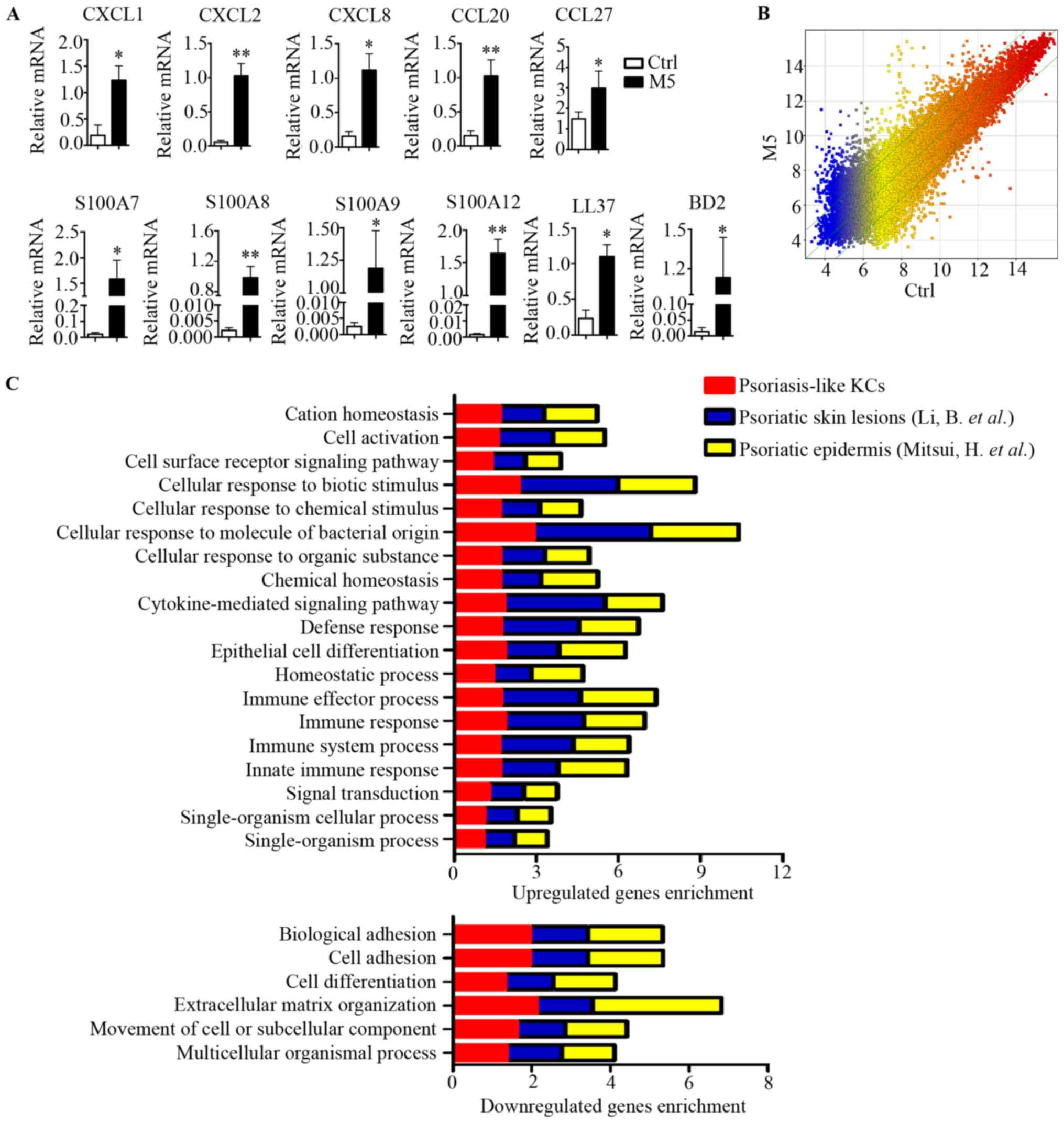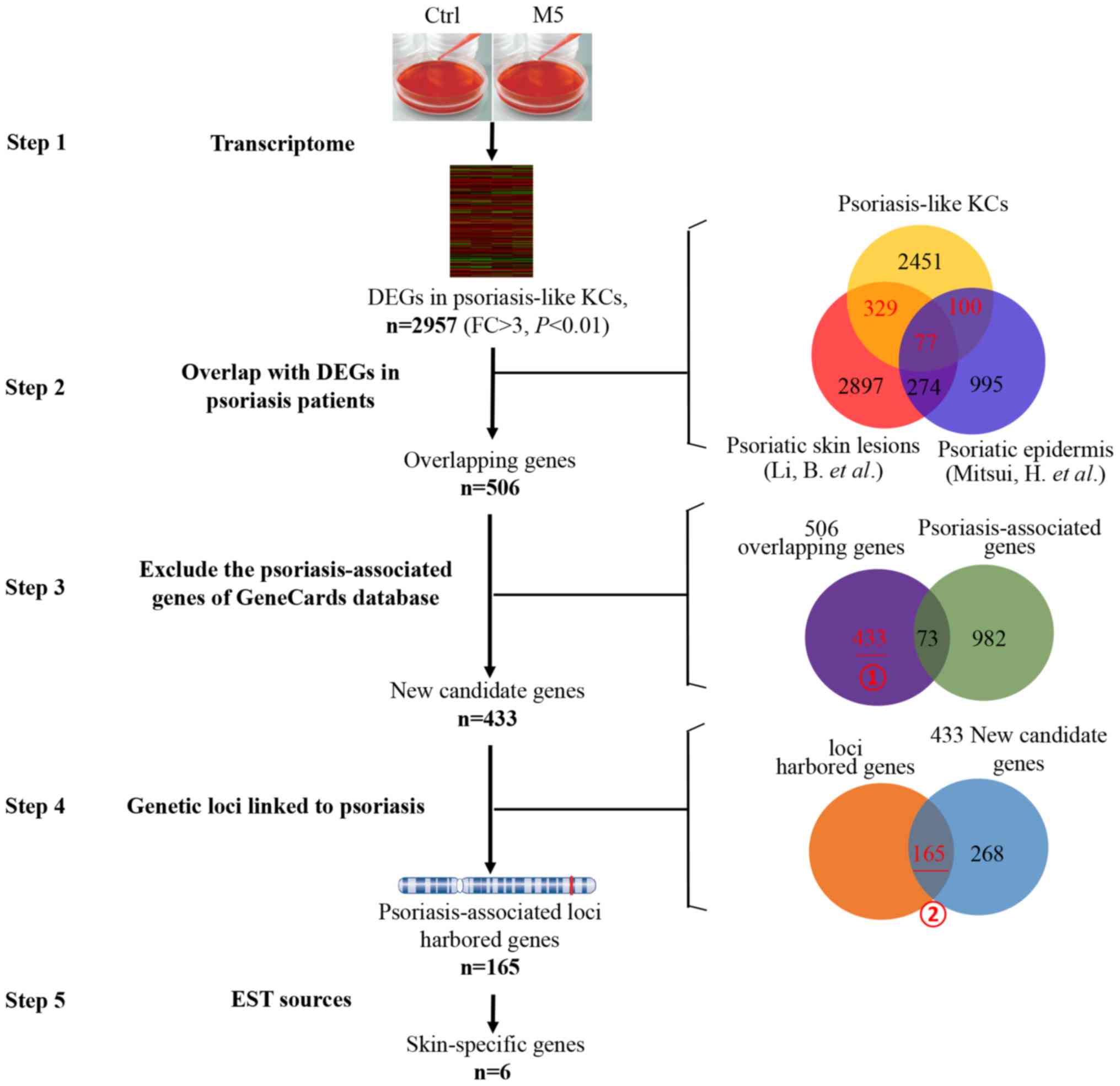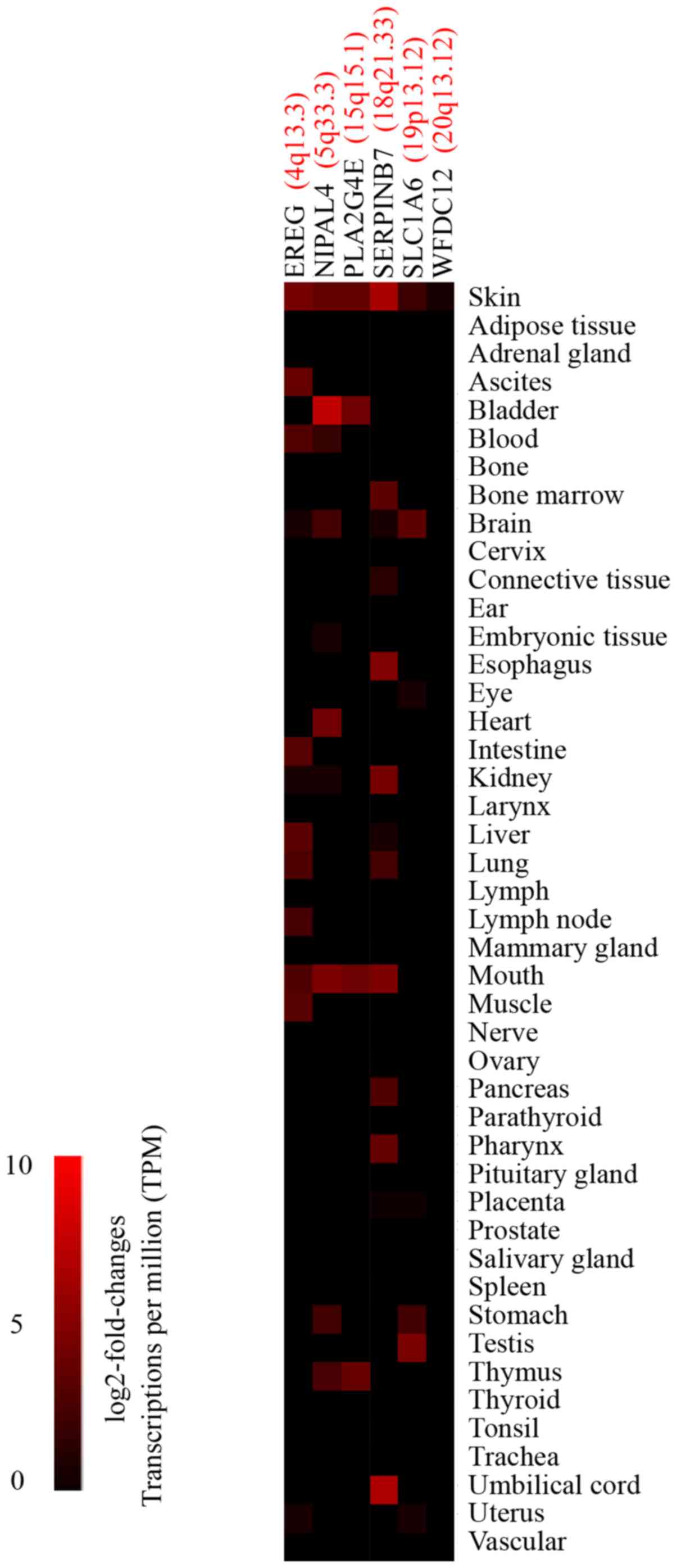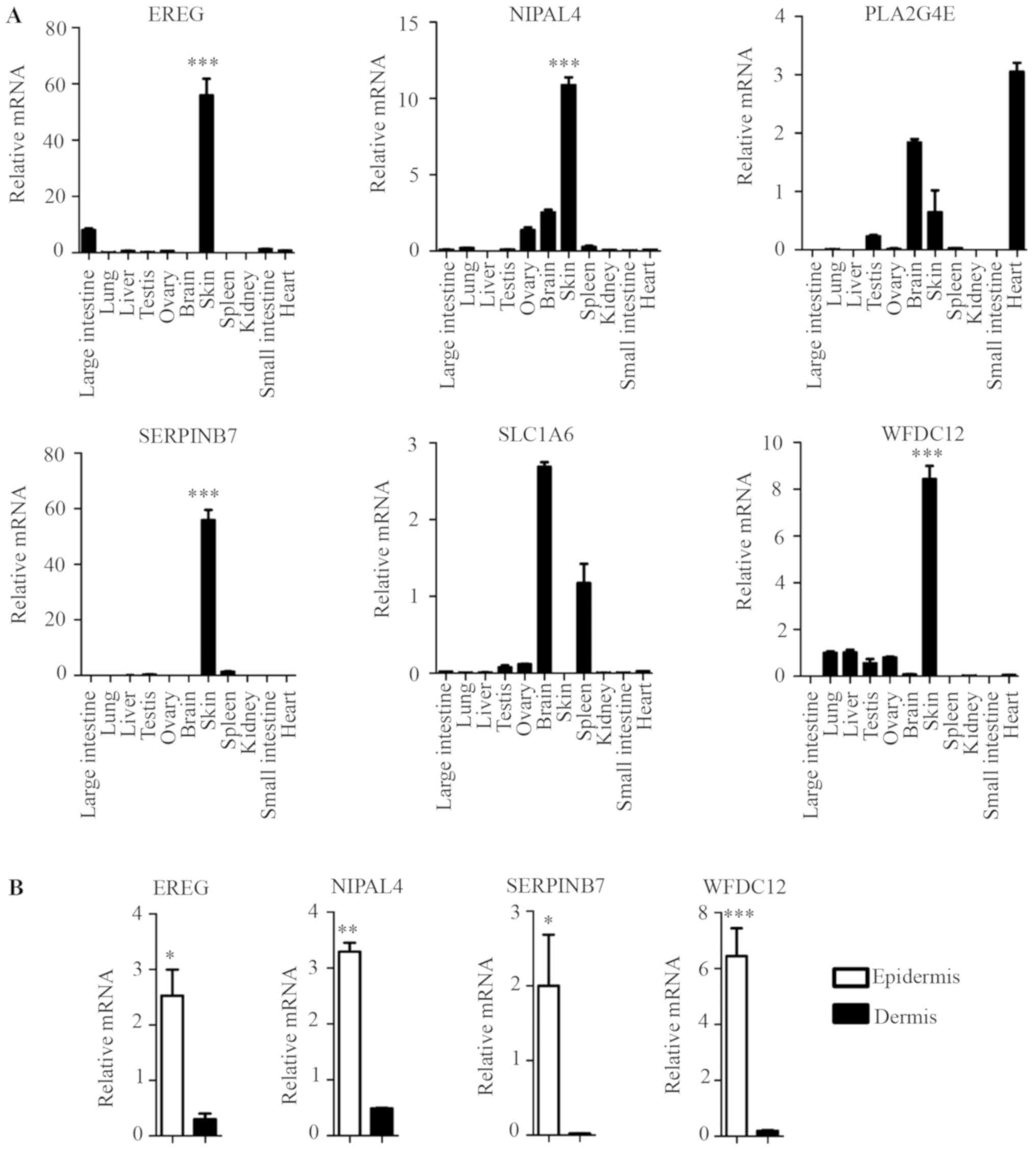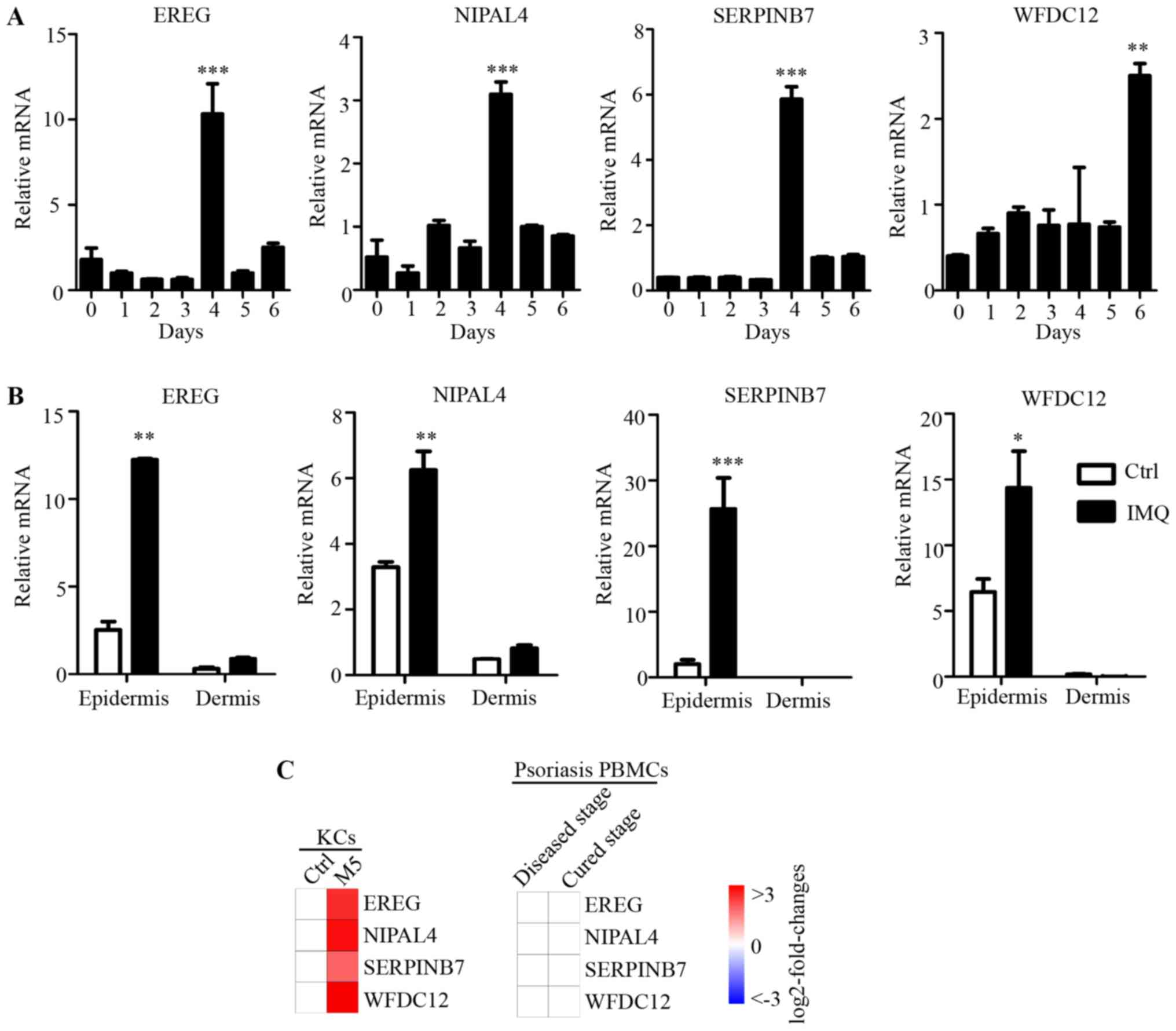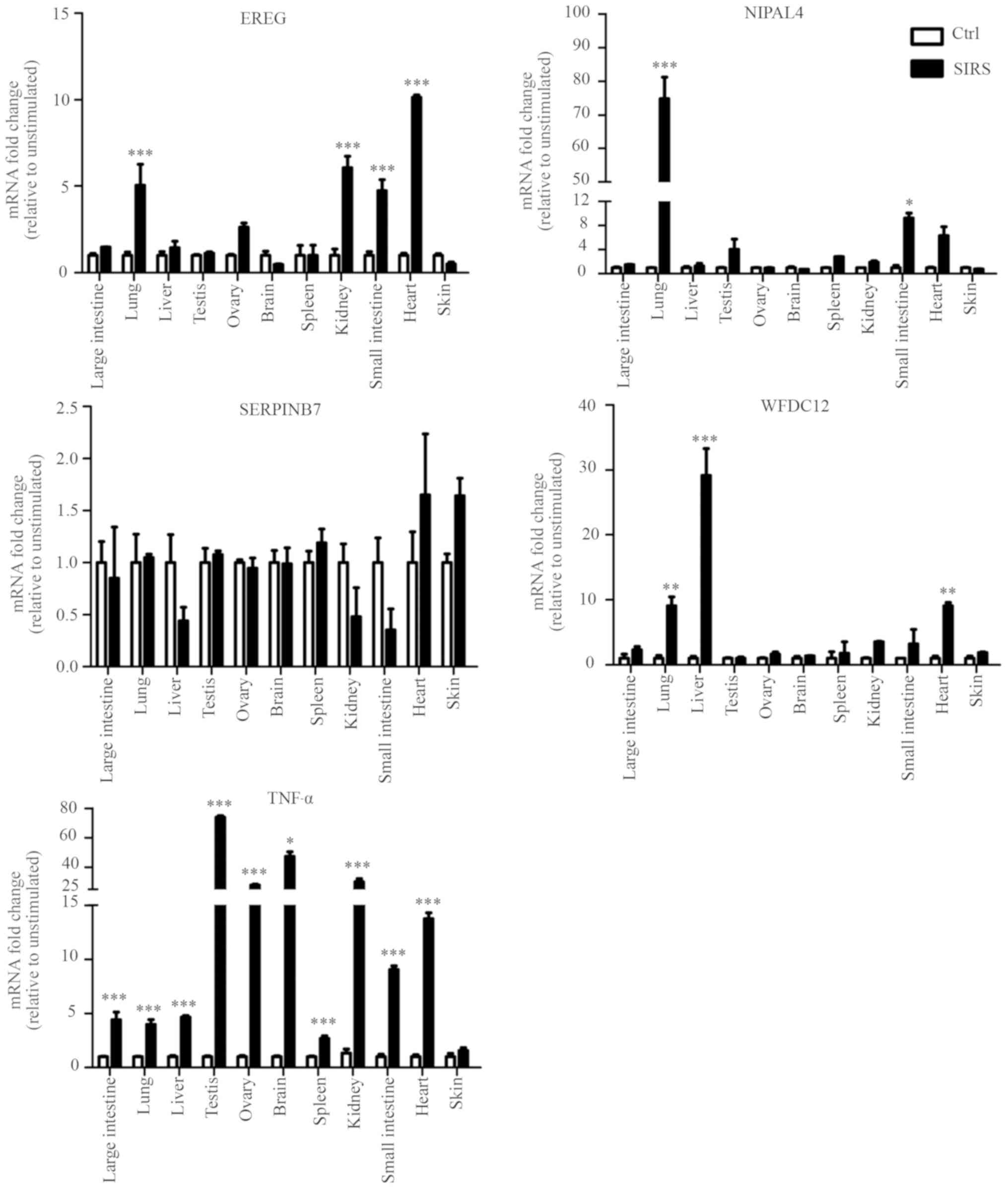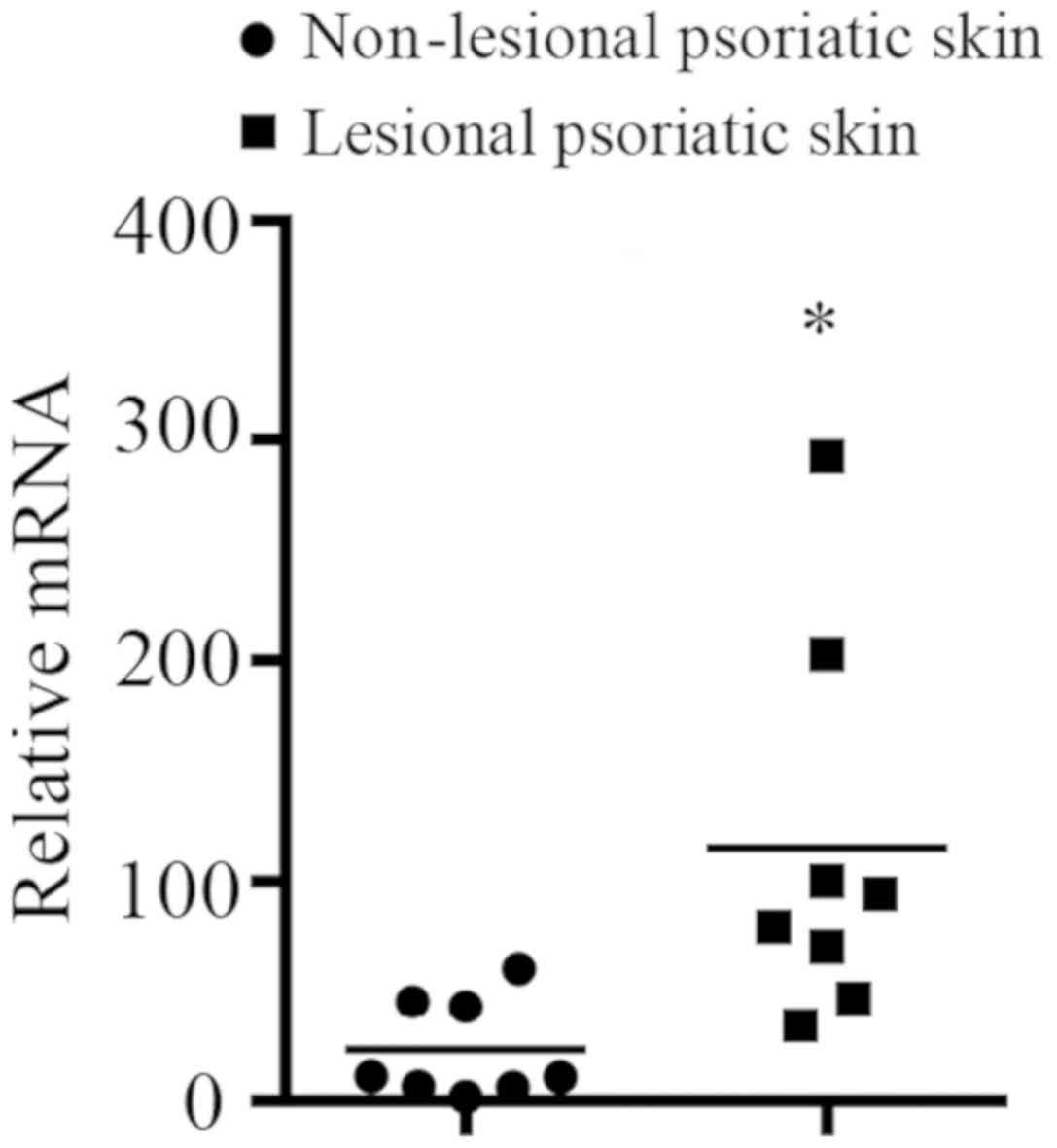|
1
|
Nestle FO, Di Meglio P, Qin JZ and
Nickoloff BJ: Skin immune sentinels in health and disease. Nat Rev
Immunol. 9:679–691. 2009. View Article : Google Scholar : PubMed/NCBI
|
|
2
|
Heath WR and Carbone FR: The skin-resident
and migratory immune system in steady state and memory: Innate
lymphocytes, dendritic cells and T cells. Nature Immunol.
14:978–985. 2013. View Article : Google Scholar
|
|
3
|
Boehncke WH and Schön MP: Psoriasis.
Lancet. 386:983–994. 2015. View Article : Google Scholar : PubMed/NCBI
|
|
4
|
Nestle FO, Kaplan DH and Barker J:
Psoriasis. N Engl J Med. 361:496–509. 2009. View Article : Google Scholar : PubMed/NCBI
|
|
5
|
Lowes MA, Suárez-Fariñas M and Krueger JG:
Immunology of psoriasis. Annu Rev Immunol. 32:227–255. 2014.
View Article : Google Scholar : PubMed/NCBI
|
|
6
|
Bos JD, de Rie MA, Teunissen MB and Piskin
G: Psoriasis: Dysregulation of innate immunity. Br J Dermatol.
152:1098–1107. 2005. View Article : Google Scholar : PubMed/NCBI
|
|
7
|
Perera GK, Di Meglio P and Nestle FO:
Psoriasis. Annu Rev Pathol. 7:385–422. 2012. View Article : Google Scholar : PubMed/NCBI
|
|
8
|
Kim J and Krueger JG: The
immunopathogenesis of psoriasis. Dermatol Clin. 33:13–23. 2015.
View Article : Google Scholar : PubMed/NCBI
|
|
9
|
Crow JM: Therapeutics: Silencing
psoriasis. Nature. 492 Suppl:S58–S59. 2012. View Article : Google Scholar : PubMed/NCBI
|
|
10
|
Williams SC: New biologic drugs get under
the skin of psoriasis. Nat Med. 18:6382012. View Article : Google Scholar : PubMed/NCBI
|
|
11
|
Liu X, Fang L, Guo TB, Mei H and Zhang JZ:
Drug targets in the cytokine universe for autoimmune disease.
Trends Immunol. 34:120–128. 2013. View Article : Google Scholar : PubMed/NCBI
|
|
12
|
Iborra M, Beltrán B, Bastida G, Aguas M
and Nos P: Infliximab and adalimumab-induced psoriasis in Crohn's
disease: A paradoxical side effect. J Crohns Colitis. 5:157–161.
2011. View Article : Google Scholar : PubMed/NCBI
|
|
13
|
Matos TR, O'Malley JT, Lowry EL, Hamm D,
Kirsch IR, Robins HS, Kupper TS, Krueger JG and Clark RA:
Clinically resolved psoriatic lesions contain psoriasis-specific
IL-17-producing αβ T cell clones. J Clin Invest. 127:4031–4041.
2017. View Article : Google Scholar : PubMed/NCBI
|
|
14
|
Leonardi C, Matheson R, Zachariae C,
Cameron G, Li L, Edson-Heredia E, Braun D and Banerjee S:
Anti-interleukin-17 monoclonal antibody ixekizumab in chronic
plaque psoriasis. N Engl J Med. 366:1190–1199. 2012. View Article : Google Scholar : PubMed/NCBI
|
|
15
|
Langley RG and Ellis CN: Evaluating
psoriasis with psoriasis area and severity index, psoriasis global
assessment, and lattice system physician's global assessment. J Am
Acad Dermatol. 51:563–569. 2004. View Article : Google Scholar : PubMed/NCBI
|
|
16
|
Guilloteau K, Paris I, Pedretti N,
Boniface K, Juchaux F, Huguier V, Guillet G, Bernard FX, Lecron JC
and Morel F: Skin inflammation induced by the synergistic action of
IL-17A, IL-22, oncostatinM, IL-1{alpha}, and TNF-{alpha}
recapitulates some features of psoriasis. J Immunol. 184:5263–5270.
2010. View Article : Google Scholar : PubMed/NCBI
|
|
17
|
Teng X, Hu Z, Wei X, Wang Z, Guan T, Liu
N, Liu X, Ye N, Deng G, Luo C, et al: IL-37 ameliorates the
inflammatory process in psoriasis by suppressing proinflammatory
cytokine production. J Immunol. 192:1815–1823. 2014. View Article : Google Scholar : PubMed/NCBI
|
|
18
|
Li B, Tsoi LC, Swindell WR, Gudjonsson JE,
Tejasvi T, Johnston A, Ding J, Stuart PE, Xing X, Kochkodan JJ, et
al: Transcriptome analysis of psoriasis in a large case-control
sample: RNA-seq provides insights into disease mechanisms. J Invest
Dermatol. 134:1828–1838. 2014. View Article : Google Scholar : PubMed/NCBI
|
|
19
|
Mitsui H, Suárez-Fariñas M, Belkin DA,
Levenkova N, Fuentes-Duculan J, Coats I, Fujita H and Krueger JG:
Combined use of laser capture microdissection and cDNA microarray
analysis identifies locally expressed disease-related genes in
focal regions of psoriasis vulgaris skin lesions. J Invest
Dermatol. 132:1615–1626. 2012. View Article : Google Scholar : PubMed/NCBI
|
|
20
|
Genetic Analysis of Psoriasis Consortium
& the Wellcome Trust Case Control Consortium 2, ; Strange A,
Capon F, Spencer CC, Knight J, Weale ME, Allen MH, Barton A, Band
G, Bellenguez C, et al: A genome-wide association study identifies
new psoriasis susceptibility loci and an interaction between HLA-C
and ERAP1. Nat Genet. 42:985–990. 2010. View Article : Google Scholar : PubMed/NCBI
|
|
21
|
Zhang XJ, Huang W, Yang S, Sun LD, Zhang
FY, Zhu QX, Zhang FR, Zhang C, Du WH, Pu XM, et al: Psoriasis
genome-wide association study identifies susceptibility variants
within LCE gene cluster at 1q21. Nat Genet. 41:205–210. 2009.
View Article : Google Scholar : PubMed/NCBI
|
|
22
|
de Cid R, Riveira-Munoz E, Zeeuwen PL,
Robarge J, Liao W, Dannhauser EN, Giardina E, Stuart PE, Nair R,
Helms C, et al: Deletion of the late cornified envelope LCE3B and
LCE3C genes as a susceptibility factor for psoriasis. Nat Genet.
41:211–215. 2009. View
Article : Google Scholar : PubMed/NCBI
|
|
23
|
Nair RP, Duffin KC, Helms C, Ding J,
Stuart PE, Goldgar D, Gudjonsson JE, Li Y, Tejasvi T, Feng BJ, et
al: Genome-wide scan reveals association of psoriasis with IL-23
and NF-kappaB pathways. Nat Genet. 41:199–204. 2009. View Article : Google Scholar : PubMed/NCBI
|
|
24
|
Sun LD, Cheng H, Wang ZX, Zhang AP, Wang
PG, Xu JH, Zhu QX, Zhou HS, Ellinghaus E, Zhang FR, et al:
Association analyses identify six new psoriasis susceptibility loci
in the Chinese population. Nat Genet. 42:1005–1009. 2010.
View Article : Google Scholar : PubMed/NCBI
|
|
25
|
Liu Y, Helms C, Liao W, Zaba LC, Duan S,
Gardner J, Wise C, Miner A, Malloy MJ, Pullinger CR, et al: A
genome-wide association study of psoriasis and psoriatic arthritis
identifies new disease loci. PLoS Genet. 4:e10000412008. View Article : Google Scholar : PubMed/NCBI
|
|
26
|
Stuart PE, Nair RP, Ellinghaus E, Ding J,
Tejasvi T, Gudjonsson JE, Li Y, Weidinger S, Eberlein B, Gieger C,
et al: Genome-wide association analysis identifies three psoriasis
susceptibility loci. Nat Genet. 42:1000–1004. 2010. View Article : Google Scholar : PubMed/NCBI
|
|
27
|
Gudjonsson JE, Ding J, Johnston A, Tejasvi
T, Guzman AM, Nair RP, Voorhees JJ, Abecasis GR and Elder JT:
Assessment of the psoriatic transcriptome in a large sample:
Additional regulated genes and comparisons with in vitro models. J
Invest Dermatol. 130:1829–1840. 2010. View Article : Google Scholar : PubMed/NCBI
|
|
28
|
Tsoi LC, Spain SL, Knight J, Ellinghaus E,
Stuart PE, Capon F, Ding J, Li Y, Tejasvi T, Gudjonsson JE, et al:
Identification of 15 new psoriasis susceptibility loci highlights
the role of innate immunity. Nat Genet. 44:1341–1348. 2012.
View Article : Google Scholar : PubMed/NCBI
|
|
29
|
Capon F, Bijlmakers MJ, Wolf N, Quaranta
M, Huffmeier U, Allen M, Timms K, Abkevich V, Gutin A, Smith R, et
al: Identification of ZNF313/RNF114 as a novel psoriasis
susceptibility gene. Hum Mol Genet. 17:1938–1945. 2008. View Article : Google Scholar : PubMed/NCBI
|
|
30
|
Antal C, Teletin M, Wendling O, Dgheem M,
Auwerx J and Mark M: Tissue collection for systematic phenotyping
in the mouse. Curr Protoc Mol Biol Chapter. 29:Unit 29A.4. 2007.
View Article : Google Scholar
|
|
31
|
El Malki K, Karbach SH, Huppert J, Zayoud
M, Reissig S, Schüler R, Nikolaev A, Karram K, Münzel T, Kuhlmann
CR, et al: An alternative pathway of imiquimod-induced
psoriasis-like skin inflammation in the absence of interleukin-17
receptor a signaling. J Invest Dermatol. 133:441–451. 2013.
View Article : Google Scholar : PubMed/NCBI
|
|
32
|
Livak KJ and Schmittgen TD: Analysis of
relative gene expression data using real-time quantitative PCR and
the 2(-Delta Delta C(T)) method. Methods. 25:402–408. 2001.
View Article : Google Scholar : PubMed/NCBI
|
|
33
|
Greb JE, Goldminz AM, Elder JT, Lebwohl
MG, Gladman DD, Wu JJ, Mehta NN, Finlay AY and Gottlieb AB:
Psoriasis. Nat Rev Dis Primers. 2:160822016. View Article : Google Scholar : PubMed/NCBI
|
|
34
|
Swindell WR, Xing X, Stuart PE, Chen CS,
Aphale A, Nair RP, Voorhees JJ, Elder JT, Johnston A and Gudjonsson
JE: Heterogeneity of inflammatory and cytokine networks in chronic
plaque psoriasis. PLoS One. 7:e345942012. View Article : Google Scholar : PubMed/NCBI
|
|
35
|
Yano S, Banno T, Walsh R and Blumenberg M:
Transcriptional responses of human epidermal keratinocytes to
cytokine interleukin-1. J Cell Physiol. 214:1–13. 2008. View Article : Google Scholar : PubMed/NCBI
|
|
36
|
Wolk K, Kunz S, Witte E, Friedrich M,
Asadullah K and Sabat R: IL-22 increases the innate immunity of
tissues. Immunity. 21:241–254. 2004. View Article : Google Scholar : PubMed/NCBI
|
|
37
|
Banno T, Gazel A and Blumenberg M: Effects
of tumor necrosis factor-alpha (TNF alpha) in epidermal
keratinocytes revealed using global transcriptional profiling. J
Biol Chem. 279:32633–32642. 2004. View Article : Google Scholar : PubMed/NCBI
|
|
38
|
Nograles KE, Zaba LC, Guttman-Yassky E,
Fuentes-Duculan J, Suárez-Fariñas M, Cardinale I, Khatcherian A,
Gonzalez J, Pierson KC, White TR, et al: Th17 cytokines interleukin
(IL)-17 and IL-22 modulate distinct inflammatory and
keratinocyte-response pathways. Br J Dermatol. 159:1092–1102.
2008.PubMed/NCBI
|
|
39
|
Chiricozzi A, Guttman-Yassky E,
Suárez-Fariñas M, Nograles KE, Tian S, Cardinale I, Chimenti S and
Krueger JG: Integrative responses to IL-17 and TNF-α in human
keratinocytes account for key inflammatory pathogenic circuits in
psoriasis. J Invest Dermatol. 131:677–687. 2011. View Article : Google Scholar : PubMed/NCBI
|
|
40
|
Rabeony H, Petit-Paris I, Garnier J,
Barrault C, Pedretti N, Guilloteau K, Jegou JF, Guillet G, Huguier
V, Lecron JC, et al: Inhibition of keratinocyte differentiation by
the synergistic effect of IL-17A, IL-22, IL-1α, TNFα and oncostatin
M. PLoS One. 9:e1019372014. View Article : Google Scholar : PubMed/NCBI
|
|
41
|
Chandra A, Ray A, Senapati S and
Chatterjee R: Genetic and epigenetic basis of psoriasis
pathogenesis. Mol Immunol. 64:313–323. 2015. View Article : Google Scholar : PubMed/NCBI
|
|
42
|
Beaudoing E and Gautheret D:
Identification of alternate polyadenylation sites and analysis of
their tissue distribution using EST data. Genome Res. 11:1520–1526.
2001. View Article : Google Scholar : PubMed/NCBI
|
|
43
|
Boutrot F, Chantret N and Gautier MF:
Genome-wide analysis of the rice and Arabidopsis non-specific lipid
transfer protein (nsLtp) gene families and identification of wheat
nsLtp genes by EST data mining. BMC Genomics. 9:862008. View Article : Google Scholar : PubMed/NCBI
|
|
44
|
Skrabanek L and Campagne F: TissueInfo:
High-throughput identification of tissue expression profiles and
specificity. Nucleic Acids Res. 29:E1022001. View Article : Google Scholar : PubMed/NCBI
|
|
45
|
Mégy K, Audic S and Claverie JM:
Heart-specific genes revealed by expressed sequence tag (EST)
sampling. Genome Biol. 3:RESEARCH00742002. View Article : Google Scholar : PubMed/NCBI
|
|
46
|
Malone K, Sohocki MM, Sullivan LS and
Daiger SP: Identifying and mapping novel retinal-expressed ESTs
from humans. Mol Vis. 5:51999.PubMed/NCBI
|
|
47
|
Wu TH, Chu LJ, Wang JC, Chen TW, Tien YJ,
Lin WC and Ng WV: Meta-analytical biomarker search of EST
expression data reveals three differentially expressed candidates.
BMC Genomics. 13 Suppl 7:S122012. View Article : Google Scholar : PubMed/NCBI
|
|
48
|
Gerber PA, Hevezi P, Buhren BA, Martinez
C, Schrumpf H, Gasis M, Grether-Beck S, Krutmann J, Homey B and
Zlotnik A: Systematic identification and characterization of novel
human skin-associated genes encoding membrane and secreted
proteins. PLoS One. 8:e639492013. View Article : Google Scholar : PubMed/NCBI
|
|
49
|
Chou RH, Wen HC, Liang WG, Lin SC, Yuan
HW, Wu CW and Chang WS: Suppression of the invasion and migration
of cancer cells by SERPINB family genes and their derived peptides.
Oncol Rep. 27:238–245. 2012.PubMed/NCBI
|
|
50
|
Hida T, Okura M, Kamiya T and Yamashita T:
Nagashima-type palmoplantar keratosis caused by compound
heterozygous mutations in SERPINB7. Eur J Dermatol. 25:202–203.
2015.PubMed/NCBI
|
|
51
|
Shirakata Y, Kishimoto J, Tokumaru S,
Yamasaki K, Hanakawa Y, Tohyama M, Sayama K and Hashimoto K:
Epiregulin, a member of the EGF family, is over-expressed in
psoriatic epidermis. J Dermatol Sci. 45:69–72. 2007. View Article : Google Scholar : PubMed/NCBI
|
|
52
|
Shirasawa S, Sugiyama S, Baba I, Inokuchi
J, Sekine S, Ogino K, Kawamura Y, Dohi T, Fujimoto M and Sasazuki
T: Dermatitis due to epiregulin deficiency and a critical role of
epiregulin in immune-related responses of keratinocyte and
macrophage. Proc Natl Acad Sci USA. 101:13921–13926. 2004.
View Article : Google Scholar : PubMed/NCBI
|
|
53
|
Haneda T, Imai Y, Uchiyama R, Jitsukawa O
and Yamanishi K: Activation of molecular signatures for
antimicrobial and innate defense responses in skin with
transglutaminase 1 deficiency. PLoS One. 11:e01596732016.
View Article : Google Scholar : PubMed/NCBI
|
|
54
|
Dahlqvist J, Westermark GT, Vahlquist A
and Dahl N: Ichthyin/NIPAL4 localizes to keratins and desmosomes in
epidermis and Ichthyin mutations affect epidermal lipid metabolism.
Arch Dermatol Res. 304:377–386. 2012. View Article : Google Scholar : PubMed/NCBI
|
|
55
|
Klar J, Schweiger M, Zimmerman R, Zechner
R, Li H, Törmä H, Vahlquist A, Bouadjar B, Dahl N and Fischer J:
Mutations in the fatty acid transport protein 4 gene cause the
ichthyosis prematurity syndrome. Am J Hum Genet. 85:248–253. 2009.
View Article : Google Scholar : PubMed/NCBI
|
|
56
|
Maier D, Mazereeuw-Hautier J, Tilinca M,
Cosgarea R and Jonca N: Novel mutation in NIPAL4 in a Romanian
family with autosomal recessive congenital ichthyosis. Clin Exp
Dermatol. 41:279–282. 2016. View Article : Google Scholar : PubMed/NCBI
|



